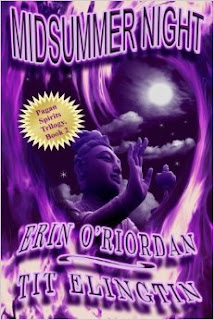Midsummer Eve and Midsummer Night are celebrated in Europe around the time of the summer solstice (which sounds a little odd, since we now consider the solstice the beginning of the season, not the middle). It’s typically observed some time between June 19 and June 26. It's a particularly popular celebration in northern Europe, especially the Scandinavian countries. In the British Isles, Ireland and Cornwall celebrate Midsummer most actively.
American cities with large Swedish populations, including New York and Chicago, sometimes have public Midsummer celebrations. Midsummer is also celebrated in New Orleans by those who practice Voudou.
In the agricultural year, Midsummer marks the transition from spring planting to summer hay-making. It’s also the harvest time for early potatoes and strawberries. In folklore, Midsummer is one of the times of year when magic is at its strongest. It’s one of the nights to be on the lookout for fairies (as in Shakespeare’s A Midsummer Night’s Dream) and/or evil spirits.
The Christianized named for Midsummer is St. John’s Day. It refers to St. John the Baptist, who is called Ivan Kupala in Russian. Gwyl Ifan is the Welsh name for St. John’s Day, and its Irish name is Oiche Fheile Eoin. The saint’s official feast day in the Catholic Church is June 24, corresponding to six months before and after Christmas. St. John’s Day is also a Masonic holiday, as John the Baptist is considered one of the “patron saints” of Masonry.
Before the Christian era, Finland celebrated Midsummer as the holiday of the god Ukko. The Irish associate it with Aine, the goddess of the moon and of love. On the Neopagan calendar, Midsummer is sometimes called Litha, a Germanic word.
Midsummer customs include gathering or ingesting certain herbs; herbs with healing powers are said to be especially effective at this time of year. Plants associated with Midsummer include the elder flower, fennel, fern, foxglove, oak, rosemary, rowan, and of course, St. John’s wort.
Some visit a stream, well or other water source said to have healing powers. In Poland, women throw wreaths of flowers into the Baltic Sea after wearing them in their hair. Young men swim out to catch the wreath of the girl they want to marry. In Spain, women who stand in the ocean until they are lapped with nine waves are said to have increased fertility.
Bonfires are also common. Jumping over the bonfire is an ancient fertility custom, and it also represents cleansing and purification. The fires are said to “call down” the sun, encouraging the sun to help the crops grow. In Ireland, on the day after Midsummer, the bonfire’s ashes are scattered in the field for good luck. In Christian times, religious icons that became broken or worn out could be destroyed in a Midsummer fire without disrespect.
In Cornwall (the south-western tip of England, south of Wales), a Midsummer (Golowan or Gol-Jowan in Cornish) ceremony has a Lady of the Flowers who casts a wreath of both medicinal and poisonous plants into the bonfire. Her traditional chant goes:
Otta kelmys yn-kemyskys
Blejyow, may fons-y cowl leskys,
Ha'n da, ha'n drok.
Re dartho an da myl egyn,
Glan re bo dyswres pup dregyn,
Yn tan, yn mok!
(In one bunch together bound
Flowers for burning here are found
Both good and ill.
Thousandfold let good seed spring
Wicked weeds, fast withering,
Let this fire kill!)
In very far northern latitudes, Midsummer is the time of the midnight sun, when there is no sunset. Further south, people might keep torches or other lights burning all night at Midsummer. Latvia observes this custom, and in more recent times has added a 3 a.m. nude run through the town of Kuldiga.
Midsummer is almost as popular as Christmas in some Scandinavian countries. The Swedish celebration includes a bonfire, a maypole, decorating the outsides of homes with flowers, and divination. Midsummer divination, like the customs surrounding St. Mark’s Day, often involves trying to find out whom one’s future spouse will be. In Denmark, witch effigies are burned on the bonfire, as is the custom in some parts of Spain.
Sources:
Midsummer
St. John's Eve
Scandinavian Midsummer's Eve
Midsummer in Cornwall
Midsummer in Ireland
Masonic holiday

Thanks for taking the time to watch my techno mash up video. :)
ReplyDeleteI truly enjoyed reading your article about midsummer. I learned something new today! One of my favorite Swedish band's made a trance song named "The Door Into Summer" and I always wondered about the significance. Now I know. Thank you. :)